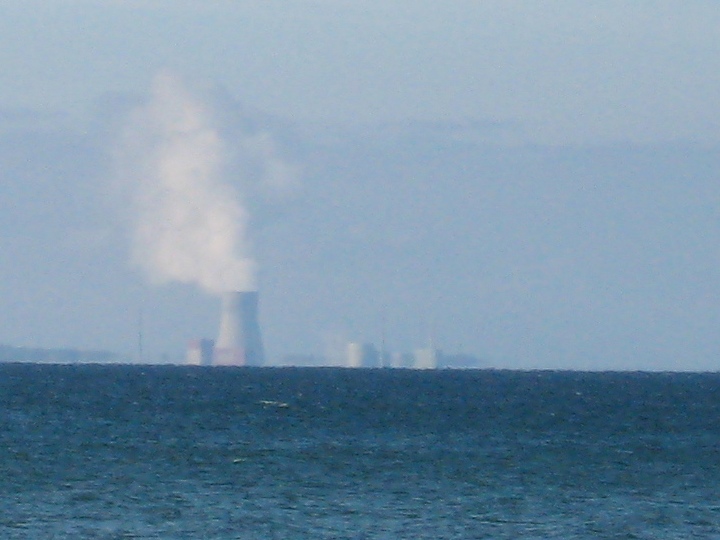For Immediate Release
August 16, 2016
Contact:
Tim Judson, Nuclear Information and Resource Service, (212) 729-1169, timj@nirs.org
Jessica Azulay, Alliance for a Green Economy, (315) 480-1515, jessica@agreenewyork.org
Watchdogs Highlight Recent and Ongoing Problems at FitzPatrick Nuclear Power Plant
Groups call attention to violations at James A. Fitzpatrick Nuclear Power Plant revealed in the NRC Integrated Inspection Report published today
Four+ year leak of highly radioactive waste – Worker radiation exposures — Failure to shut down after safety system failure
The Nuclear Regulatory Commission has released its most recent Integrated Inspection Report for James A. FitzPatrick Nuclear Power Plant in Oswego County, New York. The publicly available report covers the three month period from April 1 to June 30, 2016. The plant experienced a shutdown due to an oil leak into Lake Ontario on June 24 and has not been able to operate at full-power since, due to a condensate booster pump remaining out of service.
The report reveals for the first time that an uncontrolled radioactive leak has been ongoing in the plant’s radwaste building for four years and has not been corrected. The report says the spill “adversely affects the scope of future decommissioning.” It goes on to say that “Entergy, by its inaction over four years to correct the spillage, degradation of the solid radwaste system, and inaction to clean-up, package, and ship offsite the resultant accumulation of significant amounts of radioactive material, failed to minimize the introduction of residual radioactivity into the site.”
Other issues described in the report include incidents in which two workers were exposed to higher radiation levels than intended and a failure to shut down the plant as required after the failure of an atmospheric control system for 30 days.
“These violations highlight the ongoing dangers posed by the upstate nuclear reactors and the lax enforcement by the Nuclear Regulatory Commission,” said Tim Judson, Executive Director of the Nuclear Information and Resource Service. “Entergy has known that this highly radioactive waste spill is a problem for four years, but the NRC has not imposed any fines or other penalties. Gov. Cuomo has raised similar concerns in regard to the Indian Point nuclear reactors near New York City, but he has remained silent on nuclear safety problems at upstate reactors.”
The FitzPatrick reactor was scheduled for closure early next year because it is losing tens of millions of dollars per year. But in a deal reportedly brokered by the New York Governor’s office and underwritten by a recently approved multi-billion dollar ratepayer subsidy, Exelon Corporation has agreed to buy FitzPatrick and continue operating it. In addition to the nearly $8 billion in nuclear subsidies approved on August 1 by the New York Public Service Commission, the deal reportedly also includes the transfer to Exelon of the plant’s decommissioning fund from the New York Power Authority, a public agency. The decommissioning fund has up to $900 million of money contributed by consumers and set aside for decommissioning once the plant it retired.
The contamination caused by the leak of highly radioactive materials in FitzPatrick’s radwaste building is of particular concern because of the transfer of the decommissioning fund from public to private hands. By giving over the decommissioning fund to Exelon, the state is relinquishing its ability to influence the decommissioning process at FitzPatrick, which has now been complicated by this spill in the radwaste building, and possible leakage into the ground underneath.
As a cautionary tale, advocates point to Vermont, where Entergy has sole control over the decommissioning fund for the retired Vermont Yankee reactor. The state has been embroiled in a legal and regulatory battle to prevent the company from raiding the decommissioning fund for unrelated purposes and delaying cleanup of the site for decades.
The recently approved nuclear bailout will prop up the continued operation of the upstate nuclear reactors, at least two of which would otherwise have closed without the infusion of massive subsidies from the public.
“With the Nuclear Regulatory Commission apparently asleep at the wheel while a radioactive spill goes on for four years unmitigated, this inspection report demonstrates, once again, why nuclear power plants should be closed sooner rather than later,” said Jessica Azulay, program director with Alliance for a Green Economy. “Every day that FitzPatrick continues operating the public is at risk and the radioactive contamination problem there grows worse.”

